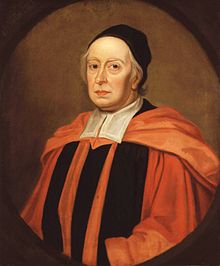John Wallis | |
|---|---|
 | |
| Born | 3 December [O.S. 23 November] 1616 Ashford, Kent, England |
| Died | 8 November 1703 (aged 86) [O.S. 28 October 1703] Oxford, Oxfordshire, England |
| Nationality | English |
| Education | Felsted School, Emmanuel College, Cambridge |
| Known for | Wallis product Inventing the symbol ∞ Extending Cavalieri's quadrature formula Coining the term "momentum"[1] |
| Spouse | Susanna Glynde (m. 1645) |
| Children | 3, including Anne, Lady Blencowe |
| Scientific career | |
| Fields | Mathematics |
| Institutions | |
| Academic advisors | William Oughtred |
| Notable students | William Brouncker |
John Wallis (/ˈwɒlɪs/;[2] Latin: Wallisius; 3 December [O.S. 23 November] 1616 – 8 November [O.S. 28 October] 1703) was an English clergyman and mathematician, who is given partial credit for the development of infinitesimal calculus.
Between 1643 and 1689 Wallis served as chief cryptographer for Parliament and, later, the royal court.[3] He is credited with introducing the symbol ∞ to represent the concept of infinity.[4] He similarly used 1/∞ for an infinitesimal. He was a contemporary of Newton and one of the greatest intellectuals of the early renaissance of mathematics.[5]
- ^ Joseph Frederick Scott, The mathematical work of John Wallis (1616-1703), Taylor and Francis, 1938, p. 109.
- ^ Random House Dictionary.
- ^ Smith, David Eugene (1917). "John Wallis As a Cryptographer". Bulletin of the American Mathematical Society. 24 (2): 82–96. doi:10.1090/s0002-9904-1917-03015-7. MR 1560009.
- ^ Cite error: The named reference
EB1911was invoked but never defined (see the help page). - ^ Kearns, D. A. (1958). "John Wallis and complex numbers". The Mathematics Teacher. 51 (5): 373–374. JSTOR 27955680.